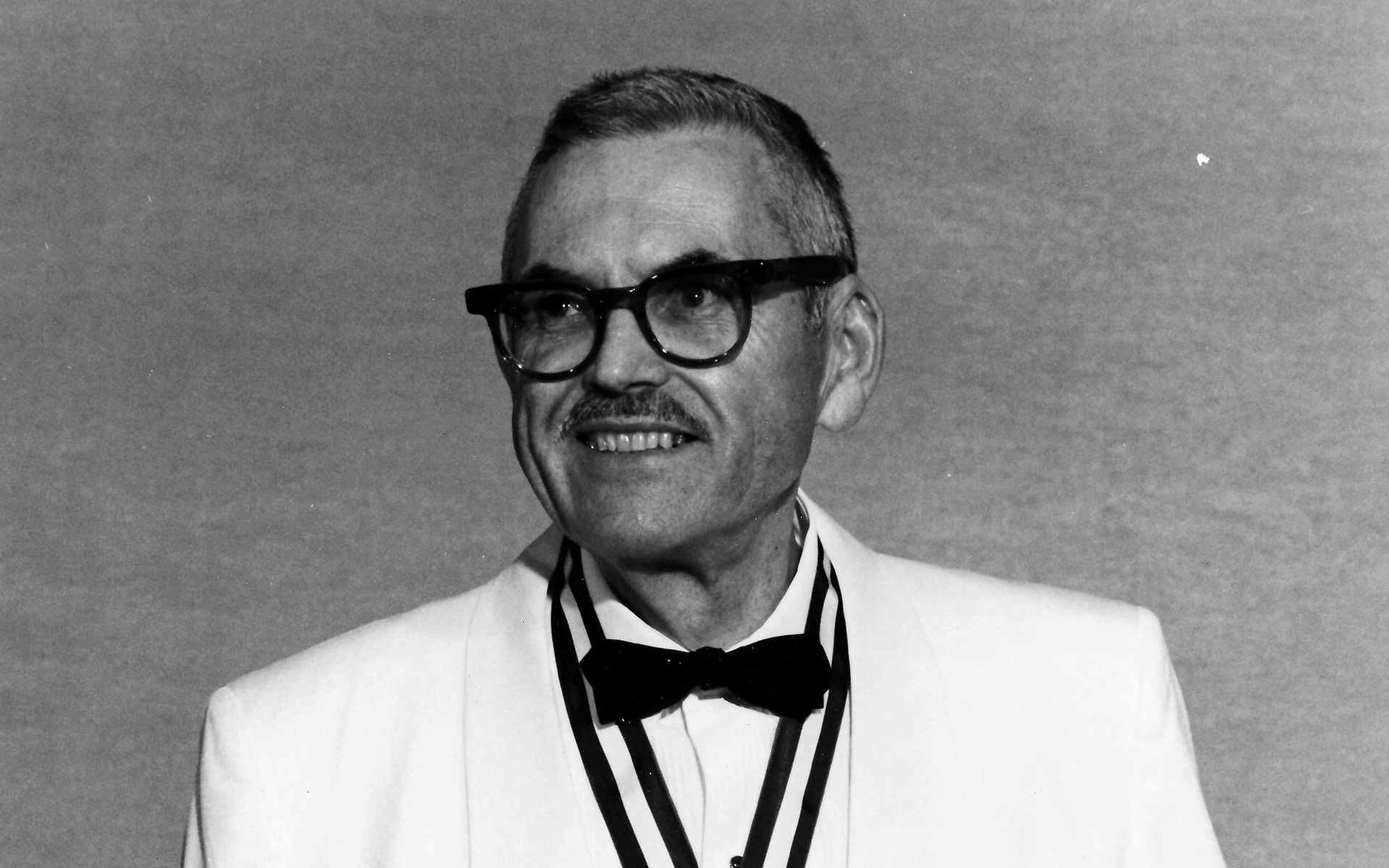
Clyde V. L. Pearson, FCSI
This is a reprise of an article originally posted on February 1, 2011, and updated in February 2014.
My father, Clyde V. L. Pearson, would have been 100 years old in 2012. He was born on February 1, 1912, and unfortunately, he passed away in 1977, at the age of 65.
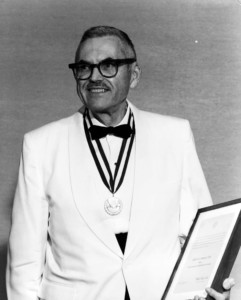
Clyde V. L. Pearson, Fellow of the Construction Specifications Institute – 1972
His mother Maude was part of a large family headed by her father Walter John (W.J.) Lindsay. Her mother Adelaide had five children but then died after giving birth to her sixth child, who was stillborn. A few years later, W.J. married Adelaide’s cousin, whom the children called Aunt Annie, and they had six more children, making a very large family. Luckily, W.J. was a successful businessman and developed the Lindsay Land and Livestock Company in Eden, Utah.
One day, Maude opened the door of their home to a handsome young man who had seen sparks from a train engine set fire to a Lindsay wheat field. It was love at first sight, and soon Maude and Vance Pearson decided to marry. Maude was close to her brother, Clyde, who was also engaged, so they had a double-wedding in Salt Lake City and then a double-honeymoon in Yellowstone Park. My father soon came along, born in 1912.
» As a sidenote, my father always thought that his name was Clyde Lindsay Pearson (named for his mother’s favorite brother), but when he got his birth certificate as an adult, it said his name was Vance Lindsay Pearson (named for his father). From that time forward, he used “Clyde Vance Lindsay Pearson.”
When my father was still a baby, Maude and Vance moved to Oregon, where Vance worked as an electrician with Oregon Power and Light. My uncle Arlo was born in 1917.
In 1922, W.J. Lindsay lost control of his holdings to a partner, so he rallied the family around him and proposed a move to California. In December, the entire Lindsay clan, including Maude and Vance, moved to Mountain View, California.
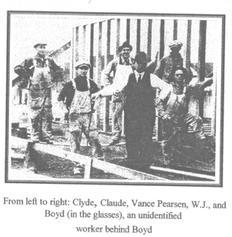
They purchased a few lots, and everyone, including W.J., donned carpenter’s overalls and started building homes. Soon The Lindsay Construction Company was building homes in San Francisco, allowing W.J. to go back to his first love, livestock. He bought a truck and became a stock buyer, buying and marketing lambs, hogs, and cattle, setting up a hog-feeding outfit at Valley Ford in Marin County.
Vance Pearson wanted to have his own business, so in the late-1920’s, he borrowed from the Bank of America and started to build homes on his own, with my father working alongside him. My father worked at other jobs, too, including a part-time job with an interior decorator. In 1928, my uncle Dale was born. Unfortunately, after the Crash, my grandfather defaulted on his loan and lost his business. He was able to get a job with Pacific Gas & Electric as an engineer and plant operator and worked with them for the rest of his career. My father had been active in the Boy Scouts, and he began work as a professional leader. In addition, he joined the U.S. Naval Reserve, and he was able to combine his love for the sea with his devotion to Scouting by working with the Sea Scout program. Because he had so much construction experience, he was also asked to build and maintain scout camps.
In the 1920’s, my mother’s family had moved from Salt Lake City to San Francisco, and my mother and father met at a church dance. (My mother said it was also love at first sight — something about those Pearson men’s blue eyes, I think.) They were married in 1935, and in 1938, the Boy Scouts asked my father to move to Santa Monica to run the Sea Scout program and be responsible for construction of the camp on Catalina Island.
[Be sure to read Full Circle on Catalina on this blog site.]
My sister was born in Santa Monica in 1939, but then the Boy Scouts again asked my father to relocate, this time to Ely, Nevada. The family lived there until December 1941. On December 7, when my father learned about the attack on Pearl Harbor, he knew that he would be called to active duty, and he immediately left for San Francisco, leaving my mother to pack up the house and then get herself and my sister to San Francisco, to live with her parents. (My mother was terrified of driving, and I can’t imagine what she went through on that long trip, especially since there were rumors that the Japanese Navy would attack the West Coast.)
My father reported to Treasure Island as a Lieutenant, USNR. Because of his long experience with Sea Scouting and sailing, he was asked to evaluate training methods for “the young Naval Reserve Officer and Enlisted Man.” Through Scouting, he knew Charles de Young Thieriot (the great-grandson of M. H. de Young, who later became the publisher of the San Francisco Chronicle), and together they wrote and published a (hand-typed, mimeographed) manual on “Piloting, Seamanship and Navigation” for the U.S. Naval Training Center (1943).
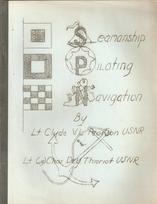
After leaving the Training Center, my father was assigned to the Pacific Theatre of War, as a Lt. Commander responsible for a flotilla of LSTs. He was actively involved in invasion after invasion, and he continued to try to find ways to reduce the launching time for the LSTs, which could take hours, often when they were in battle situations. He engineered a process that reduced the time substantially and received a commendation for it from the Secretary of the Navy.
My father had many stories about the war, and although we asked him to write a book, he never did. We know that for R&R, rather than going to Australia or Hawaii, my father was sent to Chicago to stage mock-invasions on Lake Michigan for war-bonds shows. (My father loved Big Band Music, so this was a labor of love.) There was enough time for my mother to take the train to meet him, and they were together for a week before my father was reassigned. In addition, my father was also sent on an undercover assignment to investigate a commanding officer who was mistreating the officers under his command (like Captain Queeg in Caine Mutiny).
When my father returned from the war, he rejoined the Boy Scouts and was assigned to Stockton, California. His brother, Arlo, had died in a tragic swimming accident before the war, and my father’s parents had died during the war, so his brother Dale, who was a teenager, went to Stockton with him to build a house. My mother and sister joined them, and then I was born in 1947. A few years later, my maternal grandmother died, and my mother was concerned about her father living alone in San Francisco. The Boy Scouts agreed to transfer my father to the SF Council, where he was the Assistant Executive, responsible for the Sea Scouts, construction of camps, and fund-raising.
In the mid-1960s, my father grew restless in his job with the Boy Scouts, and he decided to go into the construction industry. At first, he was a safety engineer with Bode Gravel, a ready-mix concrete company, but then he bought the rights to a concrete admixture and went into business with a partner who had a concrete sealant . My father would call on architects to try to get them to specify their products, and he would come home at night and “mix mud,” trying to make a stronger admixture.
He also became interested in computers, and in 1966, when architects and engineers were still typing specifications (and using the new invention of “White Out” to make corrections), he convinced two specifications writers (Herman Hoyer and Tom Hubbard) to join him in creating a new computer-based specification system, which was endorsed by the Construction Specifications Institute (CSI) and became known as “COMSPEC” in 1971.
My father had been a reporter on radio in the 1930’s, and he started writing, taking on the pro bono role of Editor for the San Francisco Chapter of the Construction Specifications Institute. In addition, he established his own publishing company, Tricosal Technical Press, Inc., and wrote many technical articles, including “Automated Systems Study, 1968” and “The Basic Functions of Digital Computers, 1971,” as well other works in the field of computer applications. In 1971, he received the “Citation of the Construction Specifications Institute” for his work in automated specifications, and he received the “Institute President’s Plaque” for his creative leadership. And in 1972, he was elevated to Fellowship in the Construction Specifications Institute, which was a great honor.
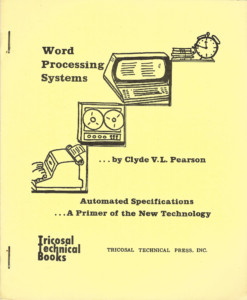
As he grew older, my father wanted to once again contribute his knowledge for subsequent generations, and he became the Executive Director of the California Industrial Education Association (now known as the California Industrial and Technology Education Association, or CITEA), a position that he thoroughly enjoyed for the rest of his life.
A friend commented on Twitter that her grandfathers were “makers” (or tinkerers). I come from a long line of “makers” as well. My grandfather was an electrician in the very early days of that industry,, when less than 25% of America was using electricity. In addition, since my father worked with men and boys, he thought that his two daughters should be “handy,” so I grew up putting things together. I developed a love of building and buildings from him and all of the Lindsays who were involved in construction. (Although the home builders weren’t always very complimentary about the role of architects.)
As I look back on my own life, it’s no wonder that I found a career in the architectural industry, combining my love of buildings with talent management, marketing, and organizational strategy, as well as writing and teaching. After all, it’s in my genes.
Thanks, Daddy. And Happy Birthday!
P.S. –
Today I live in Sonoma County, just a few miles away from Valley Ford, where Grandpa Lindsay had his livestock business, but Valley Ford is probably better known now as the starting point for Christo’s Running Fence art installation in 1976.
P.P.S. –
My cousin, Cat Lindsay, the great-granddaughter of my father’s Uncle Clyde (for whom my father was named), is an interior designer in practice with her architect husband John Newman in New York City — Lindsay Newman Architecture. It’s in her genes, too.

